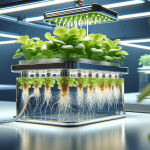This post may contain affiliate links. As an Amazon Associate, we may earn commissions from qualifying purchases.
Have you ever wondered how gardeners manage to cultivate vibrant, flourishing gardens year after year without relying heavily on artificial fertilizers? The secret often lies in the ancient, yet ever-relevant, practice of companion planting. Through thoughtful plant pairings, you can naturally enhance soil fertility and create a self-sustaining ecosystem right in your backyard. So, what are the benefits of companion planting for improving soil fertility? Let’s venture into this green-thumbed topic and dig deep into the soil benefits and symbiotic relationships that make this practice so rewarding.
Understanding Companion Planting
Companion planting is an agricultural practice that involves growing different plants in proximity to each other for mutual benefits. Though it sounds simple, the impact of strategic plant pairings can be profound. From deterring pests to improving soil health, the benefits are numerous and well-documented.
History and Origins
Companion planting isn’t just a new-age farming fad; it’s an ancient practice that dates back thousands of years. Indigenous peoples around the world have employed companion planting techniques for centuries. For instance, the “Three Sisters” method—growing corn, beans, and squash together—was a traditional practice among Native American tribes. The corn provides a structure for the beans to climb, the beans enrich the soil with nitrogen, and the squash spreads out to suppress weeds.
Basic Principles
The fundamental idea behind companion planting is that plants, much like people, have companions they thrive with and others they don’t. The practice utilizes the natural affinities (or aversions) of plants to ensure optimal growth conditions. Some plants repel pests that could harm their neighbors, while others might enrich the soil with vital nutrients.
How Companion Planting Improves Soil Fertility
Now that you have a basic understanding of what companion planting is, let’s zero in on how it specifically enhances soil fertility. Improved soil fertility refers to the soil’s increased ability to sustain plant growth, due primarily to affluences in nutrients and beneficial organisms.
Nitrogen Fixation
One of the standout benefits of companion planting is nitrogen fixation. Leguminous plants such as beans, peas, and clovers form mutualistic relationships with nitrogen-fixing bacteria in their root nodules. These bacteria convert atmospheric nitrogen into a form that plants can readily absorb. This process can dramatically enhance soil fertility, especially for nitrogen-hungry plants like tomatoes and leafy greens.
Example Pairings:
| Leguminous Plants | Beneficiary Plants |
|---|---|
| Beans | Corn, Tomatoes, Squash |
| Peas | Carrots, Cucumbers, Radishes |
| Clovers | Almost any garden vegetable |
Nutrient Cycling
Another significant advantage is nutrient cycling, where different plants uptake and return various nutrients to the soil. Deep-rooted plants, such as comfrey, pull nutrients from deeper soil layers to the surface, making them accessible to shallower-rooted plants.
Example Pairings:
| Deep-rooted Plants | Shallow-rooted Plants |
|---|---|
| Comfrey | Lettuce, Strawberries |
| Dandelion | Spinach, Bush beans |
Humus Enrichment
Plants with extensive leaf drop, like some perennial herbs and trees, contribute organic matter to the soil when their leaves decompose. This organic matter enriches the soil humus, enhancing its water retention and nutrient supply capabilities.
Example Pairings:
| Leaf-dropping Plants | Beneficiary Plants |
|---|---|
| Maple Trees | Understory Shrubs |
| Alfalfa | Grasses, Garden Vegetables |

Additional Benefits of Companion Planting
While soil fertility is a significant benefit of companion planting, it’s far from the only advantage. A well-executed companion planting scheme can lead to an array of positive outcomes for your garden.
Pest Control
Many companion plants either repel harmful insects or attract beneficial predators. Marigolds, for example, release compounds that repel nematodes, while dill attracts predatory insects that feast on aphids. This biological pest control reduces the need for chemical interventions.
Example Pairings:
| Pest-repelling Plants | Targeted Pests |
|---|---|
| Marigolds | Nematodes, Aphids |
| Basil | Mosquitoes, Flies |
| Nasturtiums | Squash Bugs, Whiteflies |
Weed Suppression
Companion planting can also help in weed control. Plants like squash and sweet potatoes have sprawling growth habits that cover the soil, thereby shading out weeds and reducing weed competition.
Example Pairings:
| Weed Suppressing Plants | Companion Vegetables |
|---|---|
| Squash | Corn, Beans (as in Three Sisters) |
| Sweet Potatoes | Peppers, Eggplants |
Improved Pollination
Certain flowering plants attract pollinators like bees and butterflies, ensuring that your fruits and vegetables set more fruit. Sunflowers and borage, for instance, are excellent at attracting these essential garden visitors.
Example Pairings:
| Pollinator-attracting Plants | Beneficiary Plants |
|---|---|
| Sunflowers | Tomatoes, Peppers, Zucchini |
| Borage | Strawberries, Squash |
Potential Challenges and Solutions
Like any gardening technique, companion planting comes with its own set of challenges. While these shouldn’t deter you, being aware of potential pitfalls can help you plan and execute your garden more effectively.
Competition for Resources
One common issue is plants competing for sunlight, water, or nutrients. For instance, pairing two nutrient-hungry plants might cause stunted growth in both.
Solution: Choose plants with complementary needs. For instance, deep-rooted carrots can pair well with shallow-rooted lettuce, as they won’t compete for the same soil depth.
Allelopathy
Certain plants release biochemicals that inhibit the growth of nearby plants, a phenomenon known as allelopathy. Black walnut trees, for example, produce juglone, which is toxic to many vegetable plants.
Solution: Research plants for potential allelopathic effects before pairing them. Keep vulnerable plants away from known allelopathic species.
Space Management
Managing garden space effectively can also be a challenge. Companion planting often requires strategic layout and timing to ensure that all plants get what they need.
Solution: Plan your garden layout ahead of time. Utilize raised beds, vertical gardening, or intercropping techniques to maximize your space.

Real-Life Success Stories
Nothing underscores the benefits of companion planting better than real-life success stories. Here are a few examples to inspire your own gardening journey.
The Jamestown Settlers
The early settlers in Jamestown, Virginia, learned companion planting techniques from Native Americans. The “Three Sisters” method was crucial for their survival, providing them with a reliable and nutritious food source. The corn, beans, and squash not only supported each other’s growth but also contributed to well-balanced soil fertility.
Modern-Day Urban Gardens
In modern urban settings, community gardens often employ companion planting to maximize limited space and resources. For instance, a rooftop garden in New York City used tomatoes and basil together, finding that both plants thrived despite the constraints of small-scale farming. The basil helped deter pests from the tomatoes, while the tomatoes provided shade for the basil, reducing water evaporation.
Getting Started with Companion Planting
So, how can you start your own companion planting journey for soil fertility improvement?
Assess Your Soil Condition
Before you begin, understand the current state of your soil. A simple soil test can reveal pH levels, nutrient content, and other critical factors. This initial assessment helps you make well-informed decisions about which plants to pair.
Choose the Right Plants
Think about what you want to achieve with your garden. Are you looking to improve nitrogen levels, deter certain pests, or just grow a bounty of produce? Your goals will guide your plant choices.
Create a Garden Plan
Sketch out your garden layout. Consider plant heights, growth habits, and seasonal changes. Remember that companion planting is not a one-size-fits-all solution. Tailor your plan to fit your unique gardening conditions.
Test and Adjust
Gardening is as much an art as it is a science. Don’t be afraid to experiment and make adjustments. Keep a gardening journal to track what works and what doesn’t, so you can refine your approach season after season.
Conclusion
Companion planting is more than just a way to grow multiple plants together; it’s a holistic approach to gardening that emphasizes synergy and sustainability. By thoughtfully selecting and pairing plants, you not only improve soil fertility but also enhance the overall health and productivity of your garden. So next time you’re out in your garden, consider which plants would make good companions. You might find yourself growing not just better plants, but a better garden ecosystem altogether.








